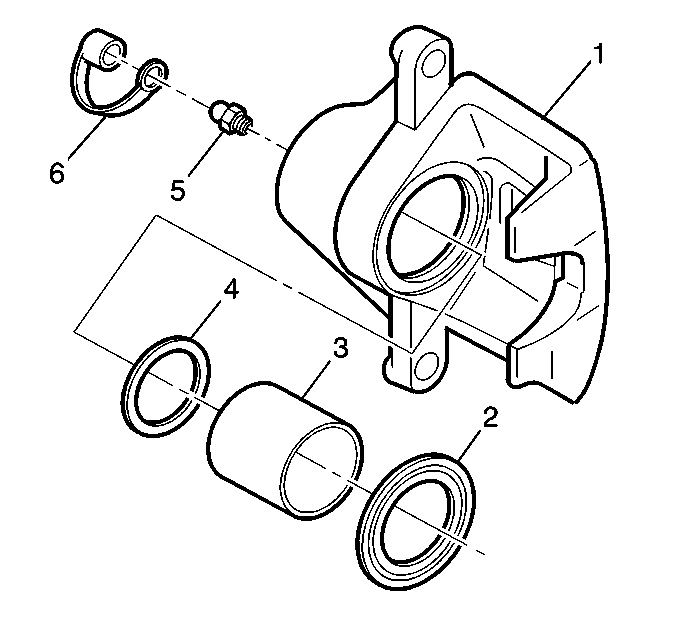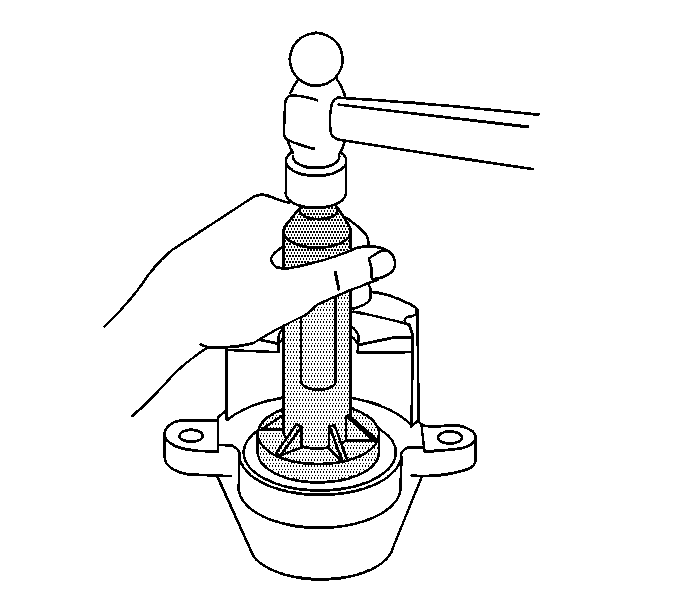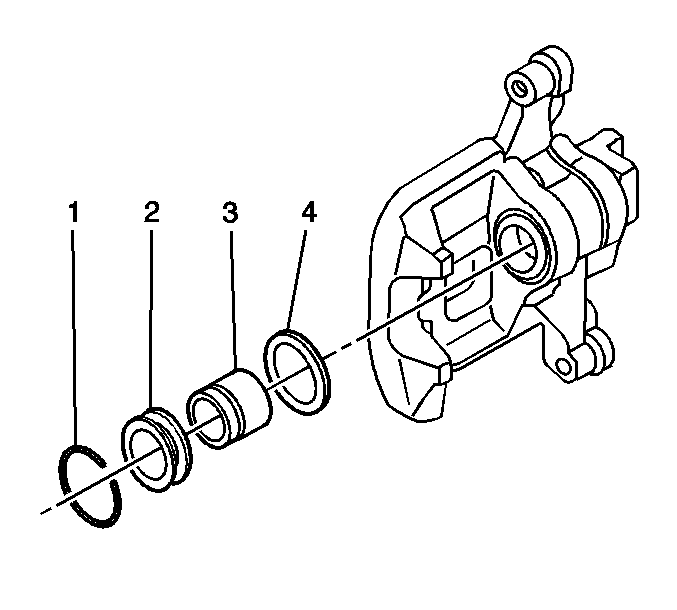
| Subject: | Revised Tool Requirements for Front and Rear Brake Caliper
Overhaul |
| Models: | 1997-2001 Buick Park Avenue, Regal |
| 1997-2001 Buick Regal (Export China) |
| 1997-2001 Cadillac DeVille, Seville |
| 2000-2001 Cadillac Eldorado |
| 1997-2001 Chevrolet Trans Sport (Export China), Venture |
| 2000-2001 Chevrolet Impala, Lumina, Monte Carlo |
| 1997-2001 Oldsmobile Aurora, Silhouette |
| 1998-2001 Oldsmobile Intrigue |
| 1997-2001 Pontiac Grand Prix, Montana, Trans Sport |
| 2000-2001 Pontiac Bonneville |
This bulletin is being issued to revise the tool requirements
for the front and rear brake caliper overhaul procedures in the Disc-Brake
sub-section of Brakes in the appropriate Service Manual. Please use the following
to replace the existing information in the Service Manual.
This information has been updated within SI2000. If you are using a
paper version of this Service Manual, please mark a reference to this bulletin
on the affected page in the Disc Brake sub-section of the Service Manual.
Front Brake Caliper Overhaul Procedure (All Above Listed Vehicles)

Caution: Do not place fingers in front of the caliper piston(s) in an attempt
to catch or protect it when applying compressed air. The piston(s) can fly
out with force and could result in serious bodily injury.
Notice: Use clean cloths to pad the interior of the caliper housing during piston
removal. Use just enough air to ease the piston out of the bores. If the pistons
are blown out, even with the padding provided, it may be damaged.
- Remove the front brake caliper from the vehicle.
- Remove the brake caliper piston from the caliper bore by directing
low pressure compressed air into the caliper bore through the fluid inlet
hole.

- Using a small wooden or plastic tool,
remove the caliper piston seal (2) from the seal counterbore in the caliper
(1) and discard the boot seal.
- Using a small wooden or plastic tool, remove the piston seal (4)
from the caliper bore and discard the piston seal.
- Remove the bleeder valve (5) and cap (6) from the caliper (1).
Important: Do not use abrasives to clean the brake caliper piston.
- Clean the brake caliper piston bore and seal counterbore and the caliper
piston with denatured alcohol, or equivalent.
- Dry the caliper piston bore and counterbore and the piston with
non-lubricated, filtered air.
- Inspect the caliper bore for cracks, scoring, pitting, excessive
rust and/or excessive corrosion.
- If light rust or light corrosion are present in the caliper bore,
attempt to remove the imperfection with a fine emery paper. If the imperfection
cannot be removed, replace the caliper assembly.
- If cracks, scoring, pitting, excessive rust and/or excessive corrosion
are present in the caliper bore, replace the caliper assembly.
- Inspect the caliper piston for cracks, scoring and/or damage to
the finished surface area. Replace the caliper piston if any of these conditions
exist.
- Lubricate the new piston seal with Delco Supreme 11®,
P/N 12377967 (in Canada, use P/N 992668), or equivalent DOT-3
brake fluid from a clean, sealed brake fluid container.
- Install the lubricated new piston seal into the caliper bore.
- Install the caliper piston into the caliper bore. Press the piston
to the bottom of the bore.
- Install the new piston dust boot seal over the piston.

- Use J-35777 to fully seat the caliper
piston seal into the counterbore.
- Install the bleeder valve and cap to the caliper and tighten the
valve securely.
- Install the front brake caliper to the vehicle.
Rear Brake Caliper Overhaul Procedure (See Vehicles Listed Below)
| • | 1999-2001 Buick Regal (Export China) |
| • | 2000-2001 Chevrolet Impala, Monte Carlo, Trans Sport (Export
China) |
| • | 1998-2001 Oldsmobile Intrigue |
| • | 1997-2001 Pontiac Grand Prix |

Caution: Do not place fingers in front of the caliper piston(s) in an attempt
to catch or protect it when applying compressed air. The piston(s) can fly
out with force and could result in serious bodily injury.
Notice: Use clean cloths to pad the interior of the caliper housing during piston
removal. Use just enough air to ease the piston out of the bores. If the pistons
are blown out, even with the padding provided, it may be damaged.
- Remove the rear brake caliper from the vehicle.
- Remove the bleeder valve and cap from the caliper housing.
- Remove the brake caliper piston from the caliper bore by directing
low pressure compressed air into the caliper bore through the fluid inlet
hole.

- Remove the retaining ring that secures
the dust boot to the caliper housing.

- Remove the piston dust boot seal (2)
from the seal counterbore in the caliper. Discard the boot seal.
- Using a small wooden or plastic tool, remove the piston seal (4)
from the caliper bore. Discard the piston seal.
Important: Do not use abrasives to clean the brake caliper piston.
- Clean the brake caliper piston bore and seal counterbore and the caliper
piston with denatured alcohol, or equivalent.
- Dry the caliper piston bore and counterbore and the piston with
non-lubricated, filtered air.
- Inspect the caliper bore for cracks, scoring, pitting, excessive
rust and/or excessive corrosion.
- If light rust or light corrosion are present in the caliper bore,
attempt to remove the imperfection with a fine emery paper. If the imperfection
cannot be removed, replace the caliper assembly.
- If cracks, scoring, pitting, excessive rust and/or excessive corrosion
are present in the caliper bore, replace the caliper assembly.
- Inspect the caliper piston for cracks, scoring and/or damage to
the chrome plating. Replace the caliper piston if any of these conditions
exist.

- Lubricate the new piston seal (4) with
Delco Supreme 11®, P/N 12377967 (in Canada, use P/N 992668),
or equivalent DOT-3 brake fluid from a clean, sealed brake fluid container.
- Install the lubricated new piston seal (4) into the caliper bore.
- Install the bottom half of the caliper piston (3) into the caliper
bore.
- Install the new piston dust boot seal (2) over the caliper piston
(3).
- Compress the caliper piston (3) to the bottom of the caliper bore.
- Fully seat the piston dust boot seal (2) into caliper counterbore.

- Install the retaining ring that secures
the dust boot to the caliper housing.
- Install the bleeder valve and cap to the caliper and tighten the
valve securely.
- Install the rear brake caliper to the vehicle.









